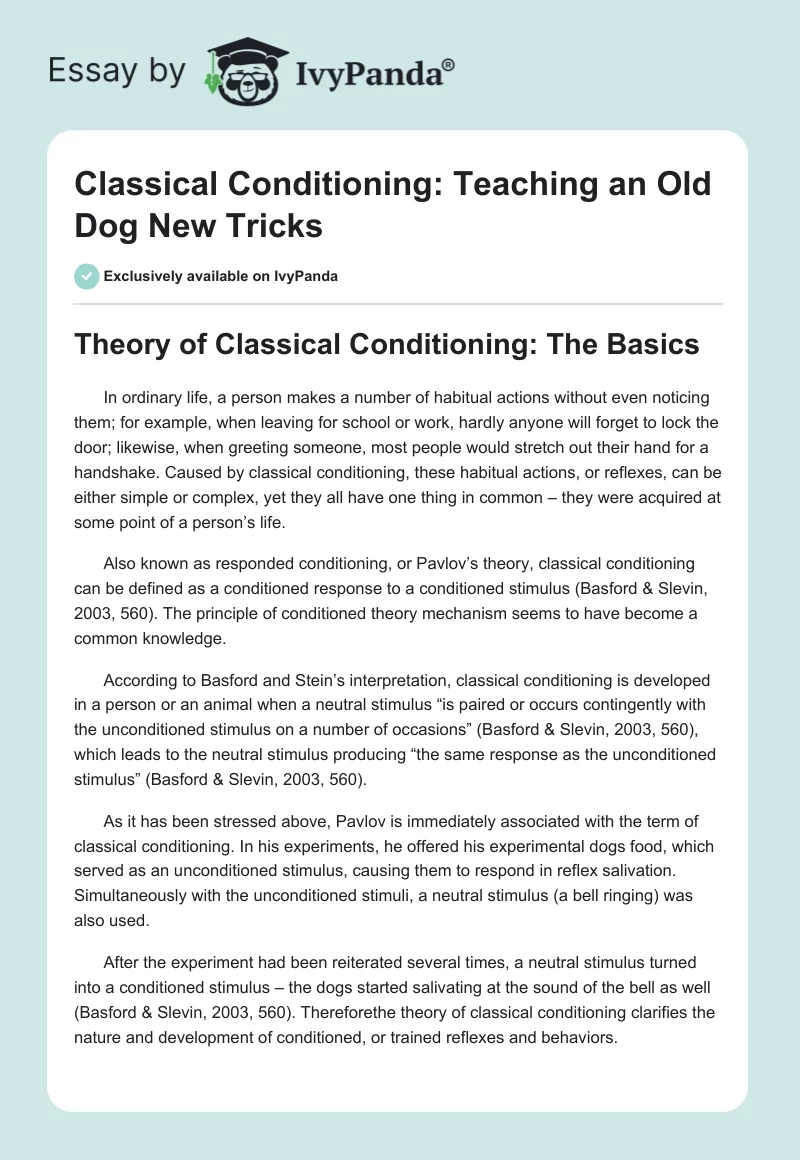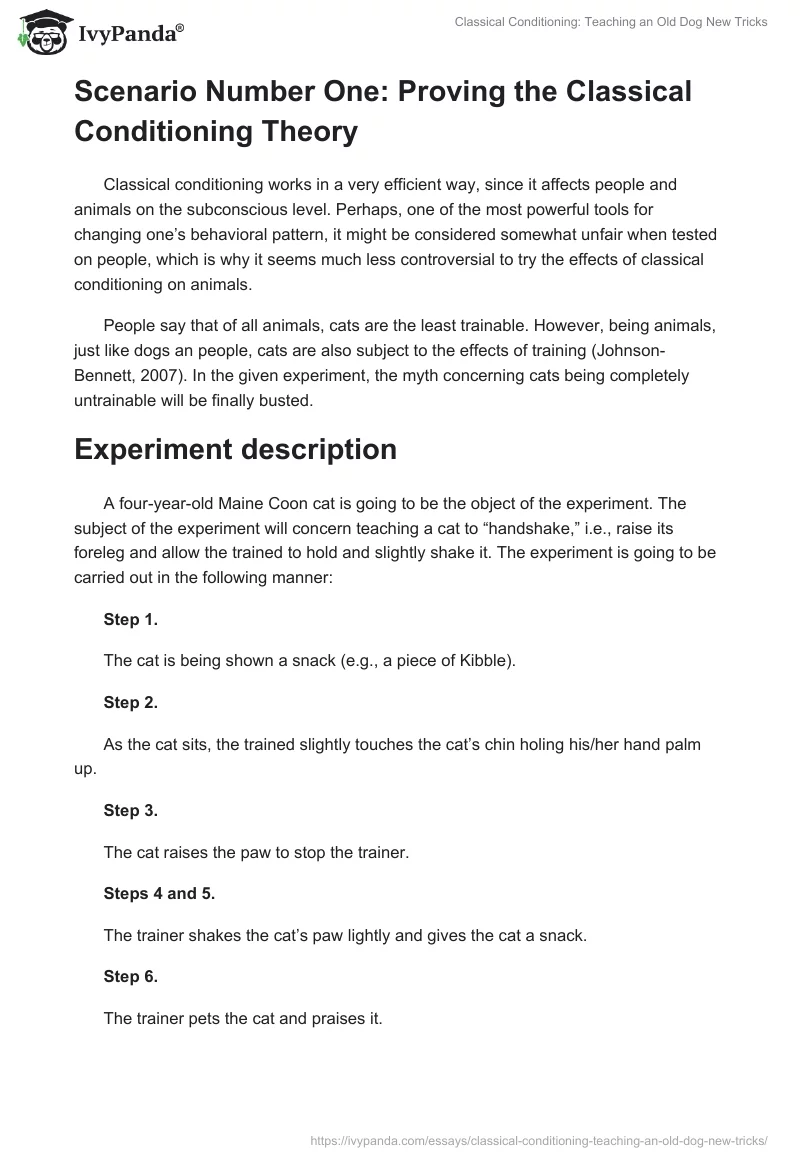Theory of Classical Conditioning: The Basics
In ordinary life, a person makes a number of habitual actions without even noticing them; for example, when leaving for school or work, hardly anyone will forget to lock the door; likewise, when greeting someone, most people would stretch out their hand for a handshake. Caused by classical conditioning, these habitual actions, or reflexes, can be either simple or complex, yet they all have one thing in common – they were acquired at some point of a person’s life.
Also known as responded conditioning, or Pavlov’s theory, classical conditioning can be defined as a conditioned response to a conditioned stimulus (Basford & Slevin, 2003, 560). The principle of conditioned theory mechanism seems to have become a common knowledge.
According to Basford and Stein’s interpretation, classical conditioning is developed in a person or an animal when a neutral stimulus “is paired or occurs contingently with the unconditioned stimulus on a number of occasions” (Basford & Slevin, 2003, 560), which leads to the neutral stimulus producing “the same response as the unconditioned stimulus” (Basford & Slevin, 2003, 560).
As it has been stressed above, Pavlov is immediately associated with the term of classical conditioning. In his experiments, he offered his experimental dogs food, which served as an unconditioned stimulus, causing them to respond in reflex salivation. Simultaneously with the unconditioned stimuli, a neutral stimulus (a bell ringing) was also used.
After the experiment had been reiterated several times, a neutral stimulus turned into a conditioned stimulus – the dogs started salivating at the sound of the bell as well (Basford & Slevin, 2003, 560). Thereforethe theory of classical conditioning clarifies the nature and development of conditioned, or trained reflexes and behaviors.
Scenario Number One: Proving the Classical Conditioning Theory
Classical conditioning works in a very efficient way, since it affects people and animals on the subconscious level. Perhaps, one of the most powerful tools for changing one’s behavioral pattern, it might be considered somewhat unfair when tested on people, which is why it seems much less controversial to try the effects of classical conditioning on animals.
People say that of all animals, cats are the least trainable. However, being animals, just like dogs an people, cats are also subject to the effects of training (Johnson-Bennett, 2007). In the given experiment, the myth concerning cats being completely untrainable will be finally busted.
Experiment description
A four-year-old Maine Coon cat is going to be the object of the experiment. The subject of the experiment will concern teaching a cat to “handshake,” i.e., raise its foreleg and allow the trained to hold and slightly shake it. The experiment is going to be carried out in the following manner:
Step 1.
The cat is being shown a snack (e.g., a piece of Kibble).
Step 2.
As the cat sits, the trained slightly touches the cat’s chin holing his/her hand palm up.
Step 3.
The cat raises the paw to stop the trainer.
Steps 4 and 5.
The trainer shakes the cat’s paw lightly and gives the cat a snack.
Step 6.
The trainer pets the cat and praises it.
The steps 1–6 must be repeated at least twenty times (i.e., the process of training will take at least a week) until the cat learns the routine subconsciously and the classical conditioning is finally formed. In the end of training, as soon as the trainer stretches his/her hand with a palm up, the cat will raise the paw to get the snack, since a handshake will be associated with a snack immediately. Technically, the given experiment is rather complicated to carry out, given the “cat nature” (Johnson-Bennett, 2007), which is why a Maine Coon breed was chosen as the type of cats who are the easiest to train.
Scenario Discussion and a Chart: How the Classical Conditioning Theory Is Going to Work
Since the given experiment presupposes that there are several unconditional stimuli that lead to respective unconditional responses, the chart is going to be different from the traditional one, yet it is going to follow the same pattern.
As the given diagram shows, the basic elements of the classical theory of conditioning are in their places. To start with, there is the neutral stimulus, which is going to become a conditioned stimulus at the end of the experiment. The two unconditioned stimuli (lifting the hand up to the cat’s chin and showing a snack at the same time) predetermine the logical uncontrolled responses (i.e., lifting the paw and wanting the snack).
As soon as the trainer shakes the cat’s paw and the cat gets the snack, the procedure is over. As soon as the procedure is carried out repeatedly, classical conditioning is formed: if the trained stretches out his/her hand with a palm up, the cat lifts its paw thinking that it will trigger getting the snack. It can be assumed that in two to three weeks, the cat will acquire a conditioned habit.
Reference List
Basford, L. & Slevin, O. (2003). Theory and practice of nursing: An integrated approach to caring practice. Chettenham, UK: Nelson Thornes.
Johnson-Bennett, P. (2007). Starting from scratch: How to correct behavior problems in your adult cat. London, UK: Penguin.


